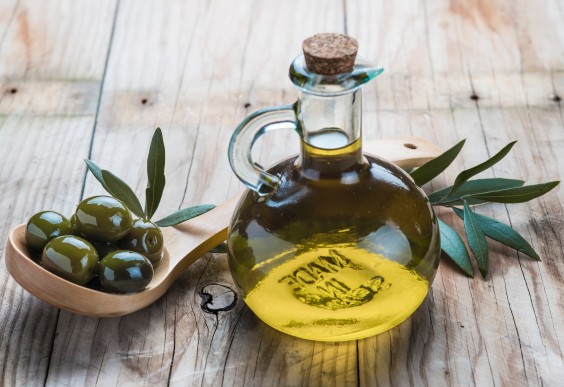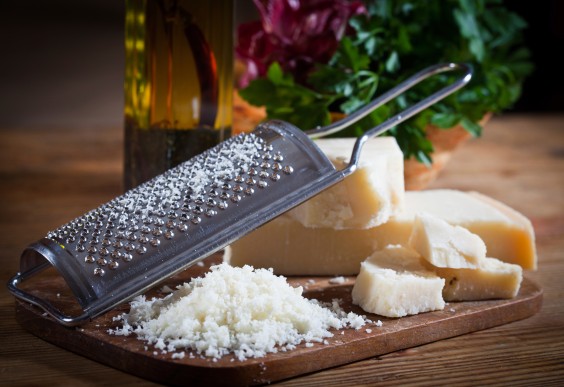Although we've all gotta do it, grocery shopping isn’t the most exciting way to spend your hard-earned dough. So when you try to fill your cart with those good-for-you ingredients along the store’s perimeter, it’s tempting to take pretty much any deal you can get.
But don't go crazy on those 75-cent avocados yet. Some ingredients that cause sticker shock will save you money in the long run, and other splurges will make your homemade food a million times tastier than takeout. We asked a group of culinary experts which big-ticket ingredients are worth the hefty price tag. Learn why you should go ahead and treat yo'self to them too.

1. Extra-Virgin Olive Oil
Don’t panic: This bottle of liquid gold isn’t going to replace your cheap, everyday cooking olive oil. In fact, when you buy a top-shelf EVOO (look for the words “first cold pressing” and, ideally, a harvest date), you shouldn’t heat it at all—instead use it in salad dressings or drizzle it at the last minute on soups or other dishes that need a touch of rich flavor. “A two-minute homemade vinaigrette can help you avoid overpriced store-bought dressings that are full of unnecessary chemicals,” says Jennifer Farley, founder of the blog Savory Simple. Combine three parts oil with one part vinegar, add salt and pepper and any other seasonings, and you are good to go.
2. Vanilla Beans
Unlike cheaper vanilla extract, a real vanilla bean can be used again and again, says Marisa McClellan, author of the book and blog Food in Jars. “After I use up the seeds, I’ll pop the scraped pod in a jar of sugar.” The vanilla infuses the sugar with its essence, leaving you with a sweetener so flavor-packed you can get away with using less of it in any recipe. And after that sugar is gone, you can steep the bean pods in plain vodka to make your own vanilla extract—for free.
3. Organic Meat
Organic produce gets a lot of attention (and a big slice of many grocery budgets), but nutritionist Katie Cavuto recommends spending your dollars on organic, grass fed-meat and wild fish before going for the fruit and vegetables. Doing so means you’ll avoid hormones and antibiotics, and your meat will have more beneficial fats than the factory-raised kind.Red meat from animals offered a grass diet increases plasma and platelet n-3 PUFA in healthy consumers. McAfee AJ, McSorley EM, Cuskelly GJ. The British journal of nutrition, 2011, Feb.;105(1):1475-2662. It’s true you can probably afford to buy less of this primo meat due to its cost, but Cavuto stresses the upside of a bit less meat in your life: “You can fill up your plate with extra vegetables. That’s a win-win.” After all, most of us have heard about the benefits of eating more produce and less meat.
4. Fleur de Sel
This hand-harvest French salt is definitely pricey compared to the usual stuff you keep in your shaker, and it shouldn’t replace good old table salt for regular seasoning. But it’s hard to beat as a finishing touch to add sparkle and texture to otherwise plain foods, according to Molly Watson, local foods expert for About.com and author of Greens and Grains. “The bright, clean flavor and distinctive crunch of fleur de sel always has a place on my counter so I can sprinkle it on as a final touch to things like salads, eggs, and grilled vegetables,” she says.

5. Imported Parmigiano-Reggiano Cheese
Step away from the green can. Your pasta dinners deserve better, says Kathleen Flinn, cooking instructor and author of The Sharper Your Knife the Less You Cry. “While it will be more expensive to purchase, you'll use less and the results will be so worth it,” Flinn explains, thanks to its concentrated, nutty flavor. To get the maximum mileage out of your wedge, she advises that you don’t discard the rind—add it to your next pot of soup to give the broth a hearty depth of flavor.
6. Dried Porcini Mushrooms
Why buy dried exotic mushrooms when their white-button brethren are so cheap? According to Michelle Tam, author of the book and blog Nom Nom Paleo, the answer can be summed up in one word: umami—you know, that meaty, savory flavor that is best described as delicious. “Toss a couple dried mushrooms into a soup or stew, and you immediately boost the flavor with no effort,” she says. To really stretch your dollar, Tam suggests grinding the dried mushrooms to a powder in a blender or food processor, mixing it with salt, and using that combination to season virtually any savory food. “It adds a punch to everything from scrambled eggs to ground meat to roasted vegetables.”
7. Whole-Milk Yogurt
Cheryl Sternman Rule dedicated her most recent book, Yogurt Culture, to the subject of the popular breakfast and post-workout snack, but she wants you to think outside the fruit-on-the-bottom cup. “Buy a quart of high-quality, whole-milk yogurt with no ingredients beyond dairy and live cultures,” she suggests. This way you can mix it with your own fruit or take it in a savory direction to add flavor (and nutrition) to your dinner plate. An organic or local yogurt—Greek style or regular, whichever you prefer—is likely your best bet. “If you buy the good stuff, you’ll definitely use it up,” Rule says.
8. Turmeric
One smart way to save money on groceries is to keep a minimalist spice drawer. Good spices are not cheap, and many times you might only use something once before it starts gathering dust. (We’re looking at you, marjoram.) But there are a few must-haves, says Monica Bhide, author of Modern Spice. “If there’s one spice you choose to invest in, I would pick turmeric.” Not only is it a key ingredient in many simple curries, you can use it to spice up basics like your scrambled eggs or even add to tropical-flavored smoothies.
No comments:
Post a Comment